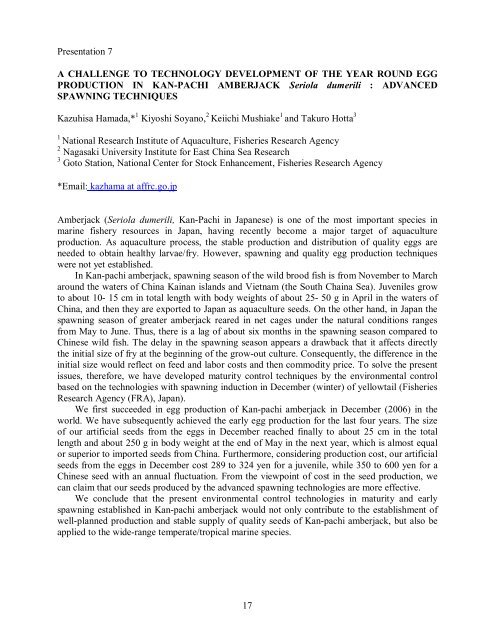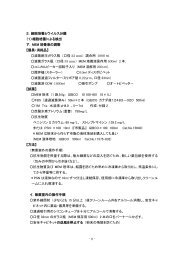Program and Abstracts(PDF)
Program and Abstracts(PDF)
Program and Abstracts(PDF)
Create successful ePaper yourself
Turn your PDF publications into a flip-book with our unique Google optimized e-Paper software.
Presentation 7<br />
A CHALLENGE TO TECHNOLOGY DEVELOPMENT OF THE YEAR ROUND EGG<br />
PRODUCTION IN KAN-PACHI AMBERJACK Seriola dumerili : ADVANCED<br />
SPAWNING TECHNIQUES<br />
Kazuhisa Hamada,* 1 Kiyoshi Soyano, 2 Keiichi Mushiake 1 <strong>and</strong> Takuro Hotta 3<br />
1<br />
National Research Institute of Aquaculture, Fisheries Research Agency<br />
2 Nagasaki University Institute for East China Sea Research<br />
3 Goto Station, National Center for Stock Enhancement, Fisheries Research Agency<br />
*Email: kazhama at affrc.go.jp<br />
Amberjack (Seriola dumerili, Kan-Pachi in Japanese) is one of the most important species in<br />
marine fishery resources in Japan, having recently become a major target of aquaculture<br />
production. As aquaculture process, the stable production <strong>and</strong> distribution of quality eggs are<br />
needed to obtain healthy larvae/fry. However, spawning <strong>and</strong> quality egg production techniques<br />
were not yet established.<br />
In Kan-pachi amberjack, spawning season of the wild brood fish is from November to March<br />
around the waters of China Kainan isl<strong>and</strong>s <strong>and</strong> Vietnam (the South Chaina Sea). Juveniles grow<br />
to about 10- 15 cm in total length with body weights of about 25- 50 g in April in the waters of<br />
China, <strong>and</strong> then they are exported to Japan as aquaculture seeds. On the other h<strong>and</strong>, in Japan the<br />
spawning season of greater amberjack reared in net cages under the natural conditions ranges<br />
from May to June. Thus, there is a lag of about six months in the spawning season compared to<br />
Chinese wild fish. The delay in the spawning season appears a drawback that it affects directly<br />
the initial size of fry at the beginning of the grow-out culture. Consequently, the difference in the<br />
initial size would reflect on feed <strong>and</strong> labor costs <strong>and</strong> then commodity price. To solve the present<br />
issues, therefore, we have developed maturity control techniques by the environmental control<br />
based on the technologies with spawning induction in December (winter) of yellowtail (Fisheries<br />
Research Agency (FRA), Japan).<br />
We first succeeded in egg production of Kan-pachi amberjack in December (2006) in the<br />
world. We have subsequently achieved the early egg production for the last four years. The size<br />
of our artificial seeds from the eggs in December reached finally to about 25 cm in the total<br />
length <strong>and</strong> about 250 g in body weight at the end of May in the next year, which is almost equal<br />
or superior to imported seeds from China. Furthermore, considering production cost, our artificial<br />
seeds from the eggs in December cost 289 to 324 yen for a juvenile, while 350 to 600 yen for a<br />
Chinese seed with an annual fluctuation. From the viewpoint of cost in the seed production, we<br />
can claim that our seeds produced by the advanced spawning technologies are more effective.<br />
We conclude that the present environmental control technologies in maturity <strong>and</strong> early<br />
spawning established in Kan-pachi amberjack would not only contribute to the establishment of<br />
well-planned production <strong>and</strong> stable supply of quality seeds of Kan-pachi amberjack, but also be<br />
applied to the wide-range temperate/tropical marine species.<br />
17



